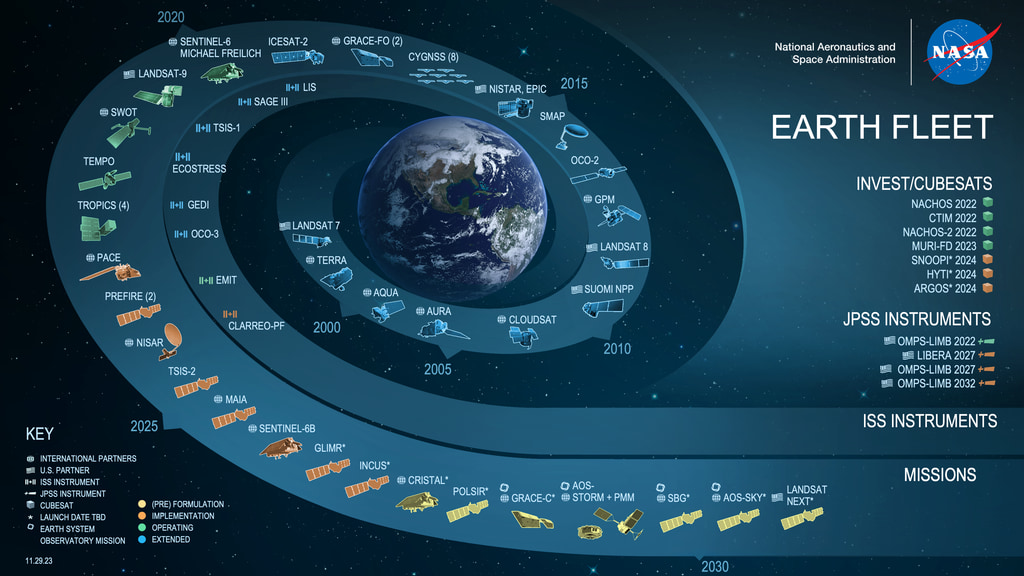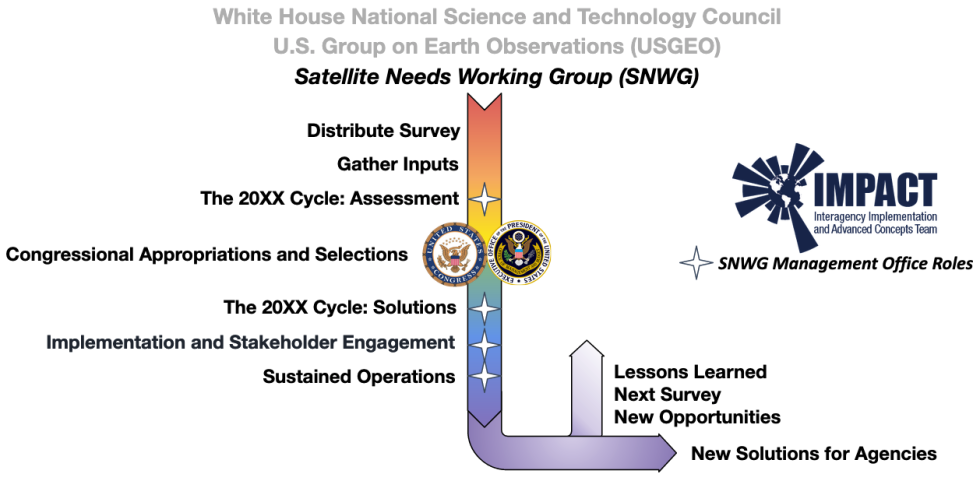Earth observations collected by satellites are essential for understanding, documenting, and forecasting all of Earth’s systems, from the geosphere to the atmosphere. The responsibilities of many United States federal agencies are directly related to such systems; they monitor water quality, respond to natural disasters, maintain our national parks, model and predict the weather, protect wildlife habitats, forecast air quality, monitor our natural resources, and much more. Each of these services requires Earth observations.
The last decade has witnessed a revolution in remote sensing technology with a dramatic increase in the number and types of Earth observations. Open data policies combined with easy access to unprecedented computing power have made satellite remote sensing more relevant than ever. While this development presents new opportunities for federal agencies to use Earth observations for the benefit of the planet, people, and countries, navigating the myriad of satellite missions and observations is not an easy task. NASA, as one of the main satellite Earth data providers to the U.S. Government, is in a unique position to assist with such navigation.
Through the Satellite Needs Working Group (SNWG), NASA coordinates with other U.S. Government satellite data providers, including USGS and NOAA, to identify, communicate, and address Earth observation needs of federal agencies. NASA is implementing a wide variety of activities to help meet federal agency needs.
A Survey of Federal Agency Satellite Data Needs
The SNWG conducts a survey of U.S. federal agencies every two years to identify what Earth observation data they need to fulfill their mission. The SNWG is part of the U.S. Group on Earth Observations (USGEO) and includes members from various federal agencies that use Earth observation data. Survey responses are assessed by NASA, NOAA, and USGS to identify agency needs, potential data gaps in the current NASA program of record, and relevant datasets. Solutions that meet these identified needs are formulated, and those that are estimated to significantly increase satisfaction of multiple U.S. agencies are selected by the Executive Branch for funding and implementation.
The SNWG Management Office
Federal agency participation in the SNWG survey is on the rise: the number of submitted surveys increased 50% in the 2020 cycle and remained elevated in the 2022 cycle. NASA established a SNWG Management Office within NASA's Interagency Implementation and Advanced Concepts Team (IMPACT) at NASA's Marshall Space Flight Center in Huntsville, AL, to manage the process of assessing agency needs for satellite Earth observations and, importantly, the implementation and operations of solutions developed by NASA to meet these needs. The SNWG Management Office is an integral part of NASA’s response to the needs of other federal agencies through its SNWG Stakeholder Engagement Program (SEP).
Facilitate the Assessment of SNWG Agency Needs
NASA leads a tri-agency assessment (with USGS and NOAA) of federal agency needs submitted through the SNWG survey. The assessment is carried out by more than 100 scientists with expertise on the geophysical observables requested by the agencies. The SNWG Management Office coordinates the assessment process, develops tools used by the assessment participants, schedules and supports follow-up discussions with each participating agency, performs statistical analysis of the survey responses, coordinates the evaluation of solutions proposed to meet agency needs, and drafts NASA’s presentation of selected solutions to the Executive Branch. After each assessment cycle, the SNWG Management Office conducts an extensive lessons learned retrospective, collecting feedback from participants that is used to inform tool refinement and process updates that streamline and support the next assessment cycle.
Oversee the Implementation and Operations of SNWG Solutions
At the heart of the SNWG process is the implementation and delivery of solutions that address the needs of federal agencies. The SNWG Management Office coordinates the status of all SNWG-funded projects at NASA, manages the implementation of solutions from each cycle, and oversees the lifecycle of each science project through operational product release.The SNWG Management office also engages end-users through the SNWG SEP. The ESDS open-source science policy is an important part of the development and implementation effort for all projects managed by the SNWG Management Office. This process will continue for all solutions arising from needs expressed in future SNWG cycles and will follow NASA’s open-source science policies permitting broad access to information on NASA-developed SNWG solutions
Provide Training and Community Engagement Around SNWG Solutions
The SNWG SEP is the key to providing training, outreach, and community engagement around NASA SNWG data products and systems through collaboration across NASA’s Earth Science Division. The program includes polling stakeholders about their training and data needs, connecting with capacity-building efforts within NASA, funding and organizing training activities such as workshops, and bringing together communities of federal and other users around funded solutions. Collaborations among federal users, the scientific community, academia, industry, and NASA’s Earth Science Division empowers these communities to integrate SNWG solutions into their research and decision-making processes.
SNWG Solution Highlights
2016 cycle:
- Harmonized Landsat Sentinel-2 (HLS) surface reflectance products
- Catalog of Archived Suborbital Earth Science Investigations (CASEI)
2018 cycle:
- ICESat-2 quicklook products
- Observational Products for End-Users from Remote Sensing Analysis (OPERA)
2020 cycle:
- Tropospheric Emissions: Monitoring Pollution (TEMPO) near real-time products
- HLS-derived vegetation indices
- Expansion of Pandora Project air quality network and air quality forecasts
- Merged atmospheric sounder/Global Navigation Satellite System (GNSS) radio occultation planetary boundary layer product
2022 cycle:
- Assessment of submitted needs is in progress
A full list of SNWG activities being implemented is available.

